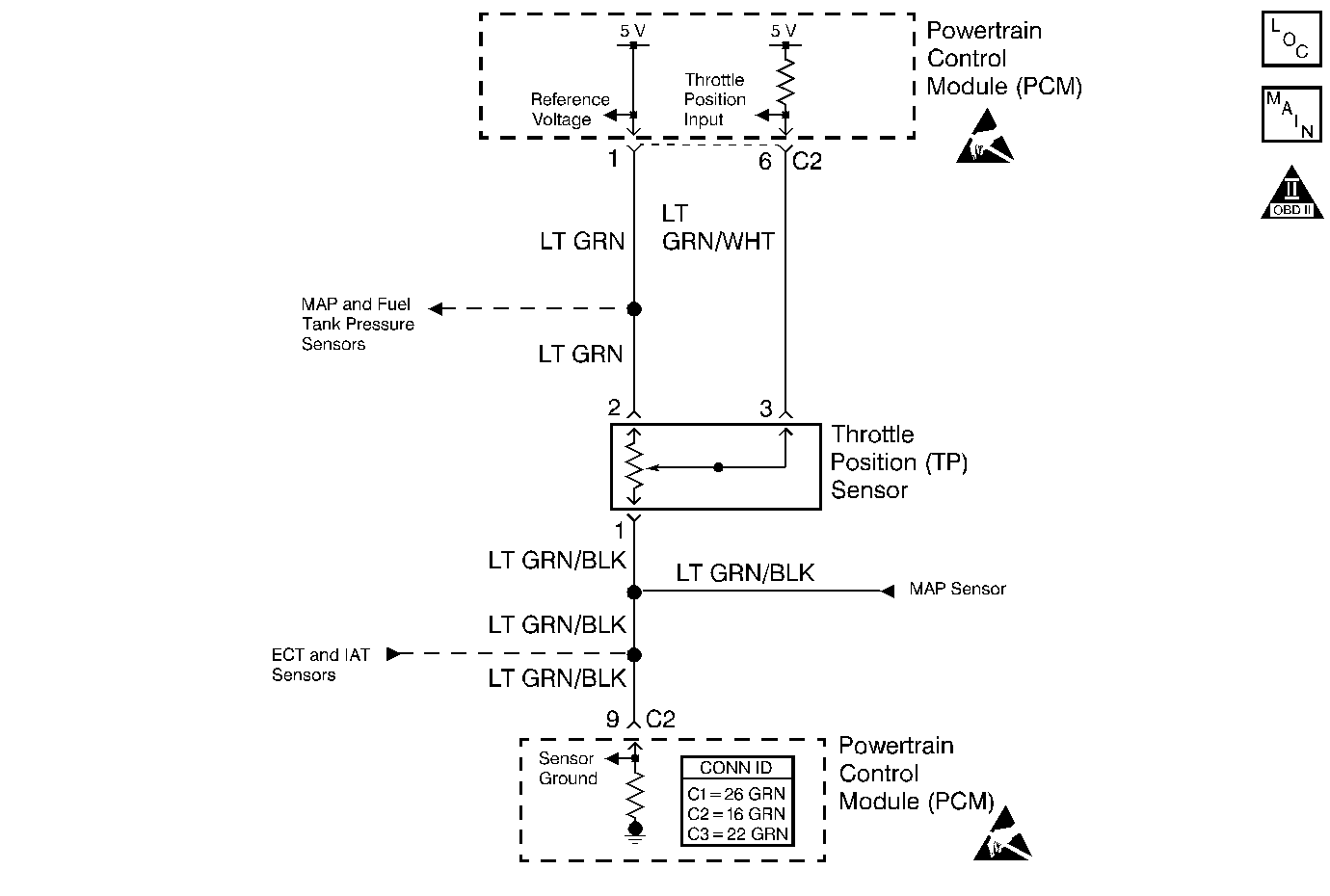
Circuit Description
The throttle position (TP) sensor contains a potentiometer whose resistance value changes as the throttle valve position changes. The powertrain control module (PCM) provides a 5 volt reference voltage to the TP sensor. The PCM reads the voltage across the TP sensor and converts the voltage into a throttle angle. The TP sensor resistance decreases as the throttle-valve opening increases, and increases as the throttle-valve opening decreases. The TP sensor voltage increases as the throttle-valve opening increases.
Conditions for Running the DTC
The ignition is ON.
Conditions for Setting the DTC
| • | A low voltage input, with a throttle opening of less than 2 percent, is indicated at the PCM. |
| • | The above condition is present for at least 0.5 seconds. |
Action Taken When the DTC Sets
| • | The PCM illuminates the malfunction indicator lamp (MIL). |
| • | The PCM records the operating conditions at the time that the diagnostic fails. This information is stored in the Freeze Frame buffer. |
| • | The PCM enters the Fail-Safe Function and assumes the throttle angle is 20 degrees. |
Conditions for Clearing the DTC
| • | The MIL turns OFF after 3 consecutive trips during which the diagnostic runs, and a fault is not detected. |
| • | A History DTC clears after 40 consecutive warm-up cycles without a fault. |
| • | Use the Clear DTC Information function of the scan tool, or disconnect the PCM battery feed in order to clear the DTC. |
Diagnostic Aids
Check for any of the following conditions:
| • | Check the resistance of the TP sensor. TP sensor resistance between terminals 1 and 2 should be between 2.5-6.0k ohms. TP sensor resistance between terminals 1 and 3 should be between 100 ohms and 20k ohms. Replace the TP sensor if the measured resistance is not within the specified values. Refer to Throttle Position Sensor Replacement . |
| • | Check for an open in the reference circuit if a DTC P0107 and P0122 are set together. |
| • | A faulty electrical connection to the PCM. |
An intermittent malfunction may be caused by a fault in the TP sensor electrical circuit. Inspect the wiring harness and the components for any of the following conditions:
| • | Backed out terminals |
| • | Incorrect mating of terminals |
| • | Broken electrical connector locks |
| • | Incorrectly formed terminals or damaged terminals |
| • | Faulty terminal-to-wire connections |
| • | Physical damage to the wiring harness |
| • | A broken wire inside the insulation |
| • | Corrosion of electrical connections, of splices, or of terminals. |
If DTC P0122 cannot be duplicated, the Freeze Frame data can be useful in determining the vehicle operating conditions when the DTC first set.
Test Description
The numbers below refer to the step numbers in the diagnostic table.
-
The Powertrain OBD system check prompts the technician to complete some basic checks, and to save the freeze frame data on the scan tool if applicable. This creates an electronic copy of the data that was taken when the fault occurred. The scan tool saves the information for later reference.
-
This step determines if a fault is present. The vehicle must be at operating temperature.
-
This step checks the reference voltage at the TP sensor.
-
This step checks the circuit that supplies the reference voltage to the TP sensor.
Step | Action | Value(s) | Yes | No |
|---|---|---|---|---|
Did you perform the Powertrain On-Board Diagnostic (OBD) System Check? | -- | |||
Is the TP sensor percentage at the specified value or below the specified value? | 2% | |||
3 |
Is the TP sensor percentage at the specified value or below the specified value? | 2% | Go to Diagnostic Aids | |
4 |
Is the TP sensor signal voltage within the specified value? | 4-5 V | ||
Measure the voltage from the harness side of the 5 volt reference circuit to ground with the DMM. Is the voltage near the specified value? | 5.0 V | |||
Was a repair necessary? | -- | |||
7 |
Was a repair necessary? | -- | ||
8 |
Was a repair necessary? | -- | ||
9 |
Was a repair necessary? | -- | ||
10 | Replace the TP sensor. Refer to Throttle Position Sensor Replacement . Is the action complete? | -- | -- | |
11 | Replace the PCM. Is the action complete? | -- | -- | |
12 |
Are any DTCs displayed on the scan tool? | -- | Go to the applicable DTC table | System OK |
